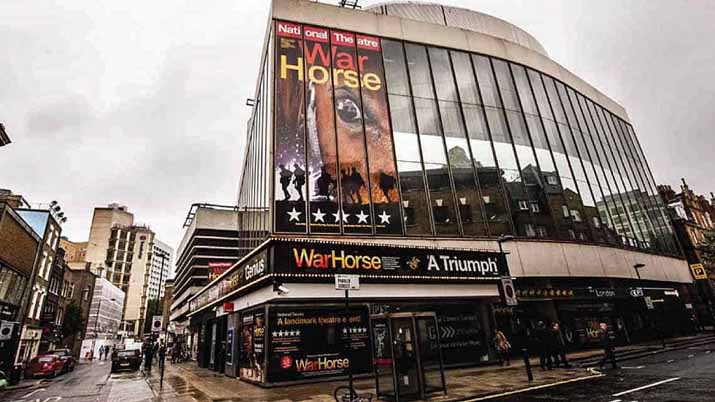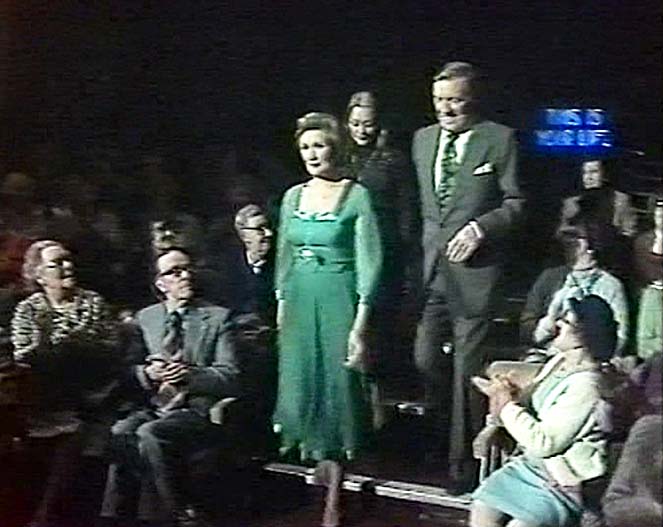Big Red Book
Celebrating television's This Is Your Life
Venues and Sets

From an old variety theatre in west London to a fully equipped modern 21st-century television studio, This Is Your Life had many homes - moving base several times over the years.
The set designs varied in style – from the conservative sturdy furniture of the 1950s and the colourfully decorated sets of the 1970s to the later bright and spacious circular arenas, all enabling the surprise guests to reveal themselves in a variety of ways - from behind curtains, through the famous sliding doors or walking down a ramp!
related pages...
the programme's best kept secrets
the iconic titles and theme tunes
the applause, laughter and tears
the show's fifty year history
Royalty plans future as opera-dance venue in Thames TV tie-up
The Stage reports on This Is Your Life's new home
Thames, this is your afterlife
The Independent reports on changes at Teddington Studios
The BBC Years: 1955-1964
With the exception of the programme's second series and the occasional outside broadcast, the programme's original nine-year run was produced at the BBC Television Theatre in Shepherd's Bush, west London.

The BBC Television Theatre photographed in 1955 - the year This Is Your Life first broadcast on British television.
The venue, built in 1903 as a music hall, was initially known as the Shepherd's Bush Empire and was designed by the renowned theatre architect Frank Matcham.
Purchased by the BBC in 1953, it was converted into a television studio-theatre - with an audience capacity of 750 - and became the home of shows such as Crackerjack, Hancock's Half Hour, The Generation Game, The Basil Brush Show and Juke Box Jury.
The King's Theatre in nearby Hammersmith was used for one year only - for the programme's second series.
The sets were reminiscent of a fashionable living room of the day, with minimal, sturdy-looking furniture, floral decorations, standard lamps and pot plants.
Guests, who appeared from behind curtains, left the set after paying their tribute and returned as a group at the end of the programme as the credits rolled.
Television monitors - later replaced by large screens - were used to relay messages from those guests unable to attend in person and to display captions and graphics designed to help enhance the life story being told.

Boxing promoter Bella Burge with Eamonn Andrews on This Is Your Life in 1958
Occasionally the set was specially dressed in a way appropriate to that week's subject - such as a library for writer Compton Mackenzie, an old BBC radio studio for broadcaster Stuart Hibberd and a circus ring for Coco the Clown.

Writer Compton Mackenzie with Eamonn Andrews and guests on This Is Your Life in 1956
The only credit for set design seen from this period appears on the very first show - when Eamonn Andrews was surprised by Ralph Edwards - and is given to Barry Learoyd:
Barry Learoyd: A prolific production designer who worked on many early BBC dramas, including adaptations of Shakespeare plays throughout the 1950s, the classic Sunday Night Theatre series and the anthology science fiction series Out Of The Unknown.
 |
 |
|
 |
 |
|
 |
 |
|
 |
 |
|
 |
||
The Thames Years: 1969-1988
The Euston Road Studios, located next to London's Euston Tower, were purpose-built for Thames Television in 1969. The largest of the company's studios - Studio 5 - was used for This Is Your Life for nine years between 1969 and 1978.

This Is Your Life was broadcast from Thames Television House on London's Euston Road between 1969 and 1978
The building, known as Thames Television House, became the home of the company's current affairs, local news, schools and religious programming and housed most of the administration and sales personnel.
The This Is Your Life production team had offices in the Euston Road building.
Eamonn Andrews presented Thames Television's London news magazine programme Today four nights a week from the studio complex between 1968 and 1977.
The studios closed at the end of 1992 when the Thames franchise ended. The building was obtained for redevelopment in 1994 and demolished in 1996.
The largest of the two main studios, Studio 5 - 59 x 30 feet wall to wall with an audience capacity of 100 - was used for This Is Your Life.
However, the studio was relatively small, and the brightly coloured, intimate sets with cloth-covered round tables often looked cramped.
It was common for guests to smoke and drink on shows in the early 1970s.
The BBC curtains were replaced by the (sometimes sliding) doors, which opened on cue, to reveal each guest, usually accompanied by a musical fanfare.
Unlike the BBC period, guests stayed on the set after delivering their tribute.
Many early Thames shows were broadcast live, so pick-ups often occurred in the studio foyer or nearby on Euston Road.

Eamonn Andrews surprised Bob Hope in Studio 5 of Thames Television's Euston Road Studios in November 1970
Names credited for set design at the Euston Road studios include:
Tony Borer
Nevil Dickin
Graham Guest
Alex MacIntyre
Sylva Nadolny
Jim Nicholson
Jack Robinson
Gordon Toms
 |
 |
|
 |
 |
|
 |
 |
|
 |
 |
|
 |
||
Between 1978 and 1980, the New London Theatre, with its large stage and auditorium, created a greater sense of occasion for just two series.

The New London Theatre was the base for This Is Your Life for just two series
Situated on Drury Lane and built in 1972, the modern theatre has a flexible seating arrangement and a maximum capacity of over 900.
However, the use of the theatre is short-lived due to the Andrew Lloyd Webber musical Cats taking up residency in 1980.
Subjects would be ushered in by Eamonn Andrews through the audience.

Eamonn Andrews led the actress Dinah Sheridan through the audience at the New London Theatre in March 1979
Names credited for set design at the New London Theatre include:
Lewis Logan
Graham Probst
John White
The Royalty Theatre in Holborn becomes home to This Is Your Life for six years from 1980.

The Peacock Theatre - formerly The Royalty Theatre - on Portugal Street, off London's Kingsway, was home to This Is Your Life between 1980 and 1986
A theatre has stood on the site since the 17th century, but the current building was built in 1960 and is located on the ground level of an office block. It was initially used as a cinema, screening Cinerama films.
Purchased by the London School of Economics and renamed the Peacock Theatre, the 1000-seat house is now used by the LSO for lectures, public talks, conferences and open days. The university has a long lease with London's principal centre for contemporary dance, Sadler's Wells, which presents many of its productions at the venue.
A similar-sized theatre to the New London, the Royalty provided a larger set, which meant more room for more guests!
Once again, Eamonn Andrews would usher the subjects through the audience and up the steps onto the stage.

Eamonn Andrews led the Coronation Street actress Julie Goodyear through the audience at the Royalty Theatre in October 1980
Series 27 and the shortened series 28 used the Thames Television studios at Teddington in southwest London.
The sets used during these two series had two entrances from which guests could appear - the traditional doorway and a side entrance adjacent to a big screen.
Names credited for set design during this period include:
Graham Guest
Peter Joyce
Jane Krall
George Lack
Jack McAdam
Jim Nicholson
David Richens
Jack Robinson
 |
 |
|
Series 22/23: 1981-83 |
||
 |
 |
|
Series 24/25: 1983-85 |
||
 |
 |
|
The Thames Years: 1988-1994
Thames Television's studios at Teddington in southwest London were the base for the new look This Is Your Life from 1988 to 1994.

The site of Teddington Studios has been associated with film production since the 1910s
There have been studios on the banks of the River Thames at Teddington Lock, Middlesex, since the 1910s. The film studios which existed from that time were bought by Warners Brothers in 1931 to produce 'quota quickies'.
Devastated by a bomb in 1944, the studios were re-opened by Danny Kaye in 1948. ABC Television bought the studios in 1958 to use for television production.
Thames Television was created by a merger of Rediffusion and ABC in 1968, and until 1992 used Teddington as the main production centre for such comedy and light entertainment shows as The Tommy Cooper Show, Morecambe and Wise, Opportunity Knocks, George and Mildred and The Benny Hill Show.
The sliding doors disappear for several series.
A large photograph of the subject was displayed on a screen on which, as in the original BBC series, messages were relayed from guests unable to attend the recording.
Names credited for set design during this period include:
Harry Clark
Jack McAdam
Jane Moorfoot
 |
 |
|
 |
 |
|
 |
 |
|
The BBC Years: 1994-2003
Although still produced by Thames Television - now an independent production company owned by Pearson Television - the programme was broadcast by the BBC from 1994.
Various studios were used over the final nine series of the programme's run, including Teddington, BBC Television Centre, ITV's London Studios on the Southbank and Fountain Studios in Wembley.

BBC Television Centre in White City, west London, officially opened in June 1960 and was the headquarters of BBC Television until 2013

The London Studios, a studio complex situated on the South Bank, was built initially for London Weekend Television in 1972 and closed in 2018

Fountain Studios, an independently owned studio complex in Wembley, was formerly the base for ITV contractors Rediffusion and London Weekend Television and closed in 2016
The sets were more extensive than ever, as sofas replaced individual chairs for the guests.
The sliding doors returned to become part of the set design for the final two series.
Production designers during this final period include:
Harry Clark
Martin Collins
Simon Jago










